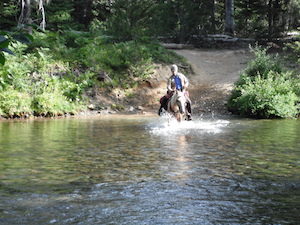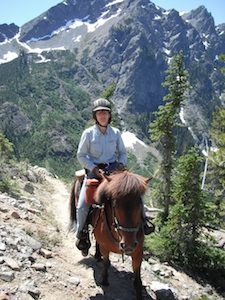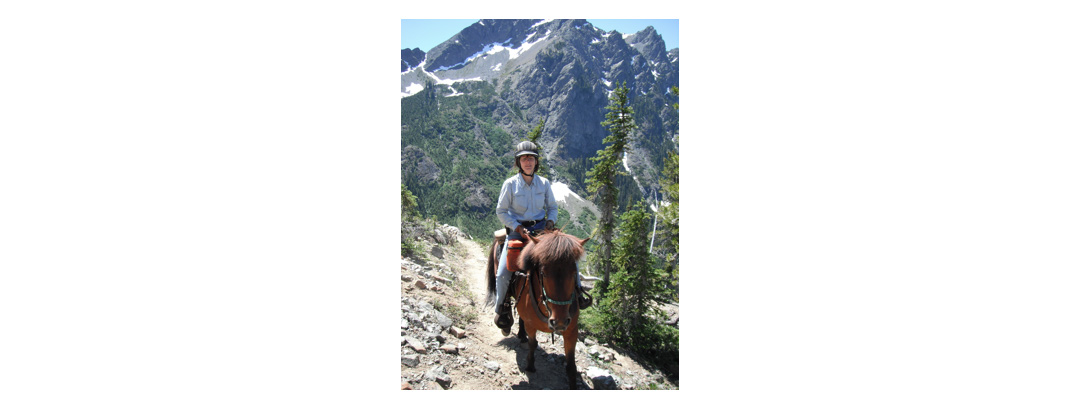The Performance Demands of Backcountry Riding
by Robert Eversole
As a trail rider you are a high performance rider, and your horse or mule is your high performance partner. By “high performance” I’m not only referring to the various extreme trail riding events we often see. Even away from judges, spectators, crowds and trophies active trail riders are asking a lot from our horses and from ourselves. So, what does high performance mean if it’s not competing for time on a manmade course filled with obstacles that bear little resemblance to the real trail riding world? Let’s examine some of the obstacles you may encounter while riding in our very own Cascade Range—no pool noodles, and no timer to race against.
Bridges: Living in the Pacific Northwest equals lots of moving water and if we want to go any distance we’re either riding on bridges or fording streams. I ride a short horse and dislike getting wet so having my mount comfortable with bridges is a must. One of my favorite bridges isn’t overly long or terribly high. What it does have is rushing water crashing loudly on the rocks beneath it. This particular bridge is in the Norse Peak Wilderness and to get to it you’ll also be traversing a boardwalk complete with slick, bouncy boards. The only entry fee required is a Northwest Forest Pass.
Water Crossings: Of course bridges aren’t always an option; we may have to take a wetter route to get to the next trail challenge, or your campsite for the night. Water crossings can often be a source of contention between riders and their animals which is why they are so often seen in trail competitions. In the real world, that blue line on the map has the potential to be the biggest challenge and potential danger of the trip. The trophy for crossing the Waptus River in the Alpine Lakes Wilderness was one of the best camping dinners ever—Backcountry Thanksgiving, complete with turkey, cranberry stuffing and mashed potatoes.

Logs: All the water that we’ve previously had to negotiate helps to grow trees, lots of trees, with branches that fall onto the trail. Some of these branches are natural cavaletti that nature provides to remind our mounts to watch their feet. Others have more in common with the jumps found on an eventing course. Get off your horse and remove them. This is an excellent reason to carry a pack saw; it’s called trail maintenance. As equestrians we share the trails with a variety of other users and one of the best ways to help keep this access is to help maintain the trails that we use. Your local Backcountry Horsemen group can help. I’ve removed excellent log obstacles from the Goat Rocks Wilderness. The prize for completing this obstacle was a wonderful cardio workout!
Rocks: The water that grows such large trees also washes off a lot of the dirt that once covered the rocky bones of the mountains. This artificial course standby is also found in the real world, with stones big and small frequently found on the trails. The reward for completing this rocky challenge on the trail out of the DeRoux Trailhead was incredible views of the even larger rocks in the background (see below).

Manmade Obstacles: Any obstacle course worth its salt will also feature a manmade challenge or two and the trail into the wilderness is no exception. Many of the trails we use are shared with hikers and bicyclists and acclimatizing ourselves, and our mounts, to handle and accept these challenges is sometimes the hardest thing about trail riding. From a biker swiftly and silently approaching, to the hiker with a horse eating fishing pole waving about, these real world obstacles are common and should be addressed before we venture forth on the trails. The hosts of competitive events would do their clients a service by incorporating more of these real world challenges into their obstacle courses.
As always for more information on the areas described here and much more please visit www.TrailMeister.com the largest horse trail and campaign directory in North America.
Originally Published July 2014 Issue

Robert Eversole, ”the trail meister,” owns www.TrailMeister.com, the largest database of horse riding and camping areas in the U.S. with free trail and trailhead information, trail maps, and much more to help horse enthusiasts experience the joys of trail riding. Robert is a registered riding instructor with PATH International, a mounted search and rescue team member, and a U.S. Marine who has served on the board of the Backcountry Horsemen of Washington (BCHW). He is enjoying his new career helping fellow trail riders stay found and safe on the trail. When not on the trail, The Trail Meister resides near Spokane, WA and teaches land navigation to a wide variety of outdoor groups across the nation. For North America’s largest horse trail and camping directory, trail tips, and more, visit www.TrailMeister.com.






